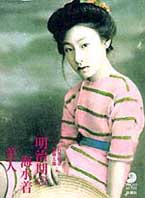Photobooks of Meiji Period Beauties
Book reviews of books about vintage photos of Japanese women in the Meiji Period.
by Philbert Ono
Beach Beauties of the Meiji Period - 明治期の海水着美人
 Reviewed on: Sept. 30, 1997
Last modified: 2005-04-03
Reviewed on: Sept. 30, 1997
Last modified: 2005-04-03
Picture collection of over 100 vintage postcards showing Meiji-Period girls in swimsuits.
Published: April 1997 Publisher: Shinchosha ISBN: 410602425X Price in Japan: ¥2,300 Qualities: Soft cover, color photos Size: A5, 151 pp. Language: Japanese Author: ISHIGURO Keisho & TAKI Rentaro 石黒敬章・滝錬太郎
Attractive book showing just about all the Meiji-Period (1868-1904) postcards that were ever made showing swimsuit beauties. The book also includes a few swimsuit postcards/photos made in the Taisho Period (1912-1926) and early Showa Period (1926-1989). You can see how the swimsuit fashion changed over the years.
The author assembled a fine collection for this book. Most pictures are in color, showing the hand-tinted coloring of the cards. Most photos on the postcards were taken in the studio. Only a few were actually taken at the beach. Meiji-Period swimsuits were one-piece outfits with horizontal stripes. The top was a buttoned, collarless shirt and the bottom was a pair of shorts. It looked more like summer pajamas. Sometimes the swimsuit was loose-fitting, and sometimes it looked skin-tight.
The models are usually posed in front of a studio background depicting a beach or ocean. A few of the girls have their hair down, and you can see how long their hair had to be to maintain the traditional hairstyle. Common props include straw hats, a wooden board (used as a floater or surfboard), a paddle, and towel. Early Showa-Period swimsuits show more leg (miniskirt-type swimsuit) and a variety of fabric patterns instead of just stripes.
This is the most complete collection of Japanese swimsuit postcards you'll ever see in a book. It is an excellent guide to any Japanese swimsuit postcards you may have. Each postcard has a short caption in Japanese and the rear portion of the book has some Japanese text explaining the history of Japanese swimsuits, beaches, hairstyles, etc. See two swimsuit photos from my postcard collection (which are also in the book). (Reviewed by Philbert Ono)
Illustrated Book of Bakumatsu-Meiji Era Beauties 幕末・明治の美人図鑑
 Reviewed on: 2002-05-20
Last modified: 2005-04-03
Reviewed on: 2002-05-20
Last modified: 2005-04-03
Comprehensive introduction to vintage photos of Japanese women.
古写真のコレクター叉は日本美人のファンには嬉しい本である。写真の点数も構成もよくできている。半端じゃない本。値段も納得できる。
Published: 2001-10-30 Publisher: Sekai Bunkasha ISBN: 4418012257 Price in Japan: ¥3,990 Qualities: Soft cover, color and sepia photos Size: A4, 231 pp. Language: Japanese Editor: OZAWA Takeshi 小沢健志
This is a marvelous compilation and introduction to 19th-century and early 20th-century photographs of Japanese women. Although nothing is in English, you can still enjoy the many old and precious photographs of women from various segments of society in those days.
First there is a nice pictorial of full-page, color photos of women from yesteryear. Then there are four chapters. Chapter 1 shows the earliest photos taken by foreign photographers (such as Felice Beato and Stillfried) who visited or settled in Japan and by the first crop of Japanese photographers (like UENO Hikoma and SHIMOOKA Renjo) who learned from the foreigners.
Chapter 2, whose title can be translated as "Illustrated Catalog of Meiji Era Beauties," is the bulk of the book. It starts with photos of women in Japan's highest social class (the Imperial family). Then it proceeds to women from former daimyo (feudal lord) families and prominent political and business circles. Toward the end of the chapter are photos of unknown women and geisha. There is also a short section of semi-nude photos. All the photos are captioned.
Chapter 3 shows the popular hairstyles and fashions of the day. And Chapter 4 is only several pages with mostly text explaining the historical background of the photographs.
It's obvious that a lot of time and effort was spent to put this book together. They had to secure the cooperation and permission of museums and collectors to reproduce the photographs. A number of prominent experts on Japanese vintage photography (such as Takio Saito of the Yokohama Archives of History and Keisho Ishiguro) also wrote the text.
Since this book was written for the layman, it is easy to read for most Japanese people. If you are a vintage photograph collector or dealer, it is likely that you will recognize some of the photos in this book. Although it will not help you appraise your vintage Japanese photos, this book will help you find out the background of the photographs you may have. (Reviewed by Philbert Ono)